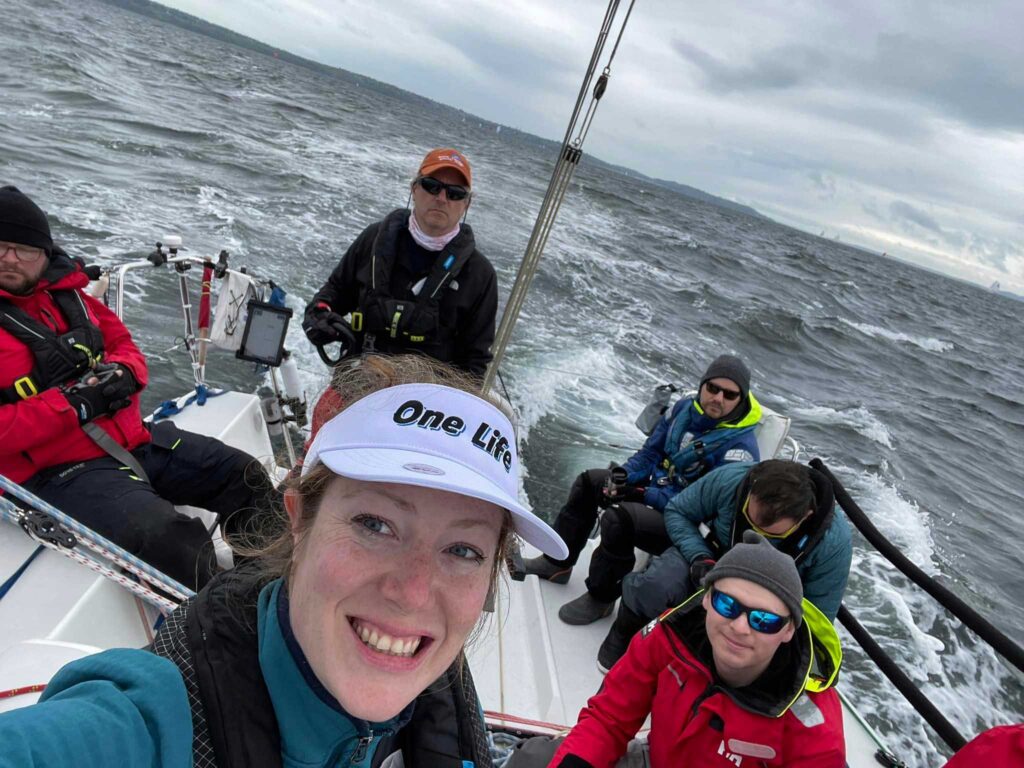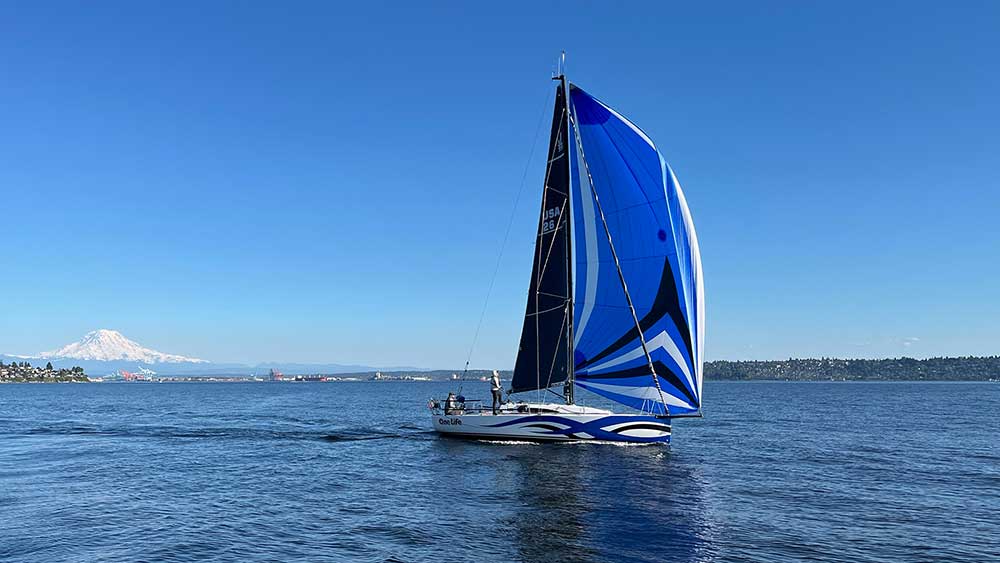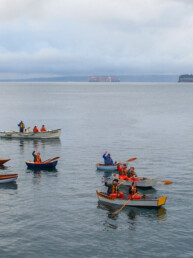The skipper of the J/99 One Life shares the story of a pair of dichotomous springtime distance races. They won their class in each event.
Smith Island
This season has been memorable for strong winds, including 50 knots true just off Meadow Point collapsing masts and shredding sails one weekend. Seattle Yacht Club’s Smith Island Race, the first of their Tri-Island Series, created more breeze-on memories for its participants.
The Tri-Island Series is a sequence of three distance races of decreasing length, running in April, May, and June. The Smith Island Race, which alternates years with the Protection Island Race, takes place in April and is the longest of the series at 85 miles for the long course, and is also a qualifier race for races like Swiftsure and Van Isle 360. It’s always a long and compelling journey.
A strong southerly had the fleet scudding north to Smith Island under platinum skies and spinnakers in winds ranging from the teens to the 20s, halfway across the Strait of Juan de Fuca’s easternmost edge. Blown kites were an early feature, but wind with the tide kept seas flat and boats fast. For our J/99 One Life, it was a wonderful sleigh ride north to just past Marrowstone, when sea state and wind shifts had the crew on watch douse the spinnaker and go to reaching under reefed main and a freshly repaired J3. Thanks to a lack of sleep the night before, I napped for much of our northbound blast.
And that, my friends, is where the fun ended.
Anyone who sails Puget Sound for any length of time knows strong winds against strong tides creates a dismal sea state. Slab-sided waves, otherwise unremarkable for their 3 to 5 foot height, stack together with short 10 to 15 foot periods between wave tops to make a truly miserable ride. Add cold weather and rain, and you have a recipe for rather comprehensive misery.
On our boat, nearly half our crew were busily using the emesis bags stocked aboard—many of whom had never had seasick issues previously. Proving good crew always pick each other up, those who weren’t sick and weren’t driving or trimming main, swapped out empty bags for full, pushed electrolyte loaded water bottles, and generally raided the on-board pharmacy for anti-seasick meds to help get folks to pull their crewmates from the depths of despair. After being seasick during the critical night hours in the 2022 Swiftsure race, I’d slapped on a scopolamine patch before we left the dock and wasn’t seasick. My northbound naps earlier in the race also proved fortunate as I could share more of the load with the sick folks—some of the same people who picked me up during my nauseating Swiftsure experience.
Doesn’t racing sound fun?

Winds kept building into the high 20s, as did the waves. The carnage down below on One Life was impressive. The head door came off, shortly followed by the toilet seat and cover. Handholds had cracks as our crew tried to keep from being tossed about. It was easier to shuffle on hands and knees with the boat pitching like some deranged mechanical bull while heeled over 25+ degrees all the time. I drove during the worst of it, but once the winds slowed down and the tide shifted I was able to go below and it still felt like being inside one of those old Fisher Price popcorn roller toys. (Editor’s note: Sailing on Farr 39 Tacyhon, highly experienced sailor and sailmaker Kerry Sherwin deemed the southward transit near Marrowstone simply, “The worst I’ve ever seen it.” Here’s skipper Nicholas Leede’s Youtube video of their Smith Island Race.)
Tacks became less about strategy and more about trying to find slightly flatter water to keep the crew safe and the boat from slamming into a wave and completely stopping. Fortunately, we managed that until the tide shifted and the seas went from full suck to slightly less full suck.
“Type 2 Fun” is defined as a decidedly un-fun time during an experience which, after time, becomes fun in retrospect. I’ve had many, many Type 2 sailing experiences. Though it’s only been a few weeks, I’m pretty sure this one is firmly Type 3: Obliterating during and, after time, still dreadful.
For One Life, we spent 14 hours on the water with a total distance sailed of a little over 100 miles; so by Smith Island Races on a boat like ours, that’s reasonably fast. That’s not the real story, though. The real story was a 5-hour trip north and a 9-hour bash home. Our effort was good for a first in class, however, and what I’d estimate might be third overall (if I do some slight-of-hand with our ORC rating to compare our times with the ORC fleet—oddly, despite having gone through the ORC measuring process for the 2023 Van Isle 360 race, yours truly entered One Life in the PHRF class).
In the ORC Long Course, John Murkowski’s J/122 Joy Ride got the bullet in ORC Class 3 and overall on adjusted time. The Leede’s Farr 39 Tachyon won ORC Class 2 by 49 seconds adjusted over Jonathan Cruse’s Freja. John Buchan’s TP-52 Glory took the ORC 1 win. Line honors went to Alan Lubner’s Reichel/Pugh 55 Zvi.
For the short courses, Moose Unknown led the J/105 fleet home. The Quest 30 Charlotte took first in Class 6. J/80 Jolly Green led a mixed fleet in Class 8 and the Norlin 34 Runaway topped the charts in the Cruiser/Racer course. Kudos, by the way, to the SYC Race Committee who were probably also questioning their life choices most of the day.
Ultimately, Smith Island 2024 was a memorable one that I’d kind of like to forget.
Vashon Island
For those who bashed their way south on consecutive cold, gloomy, blustery weekends for the SYC Smith Island Race and the STYC Race to the Straits, the warm sunshine and light breezes forecast for Seattle Yacht Club’s Vashon Island Race—the second installment of the Tri-Island Series—were probably a relief. Even without any wind, the chance to bob around in nice weather without feeling like a cold and soggy pachinko ball was most welcome.
The Vashon Race entails a 47-mile clockwise circumnavigation of Vashon Island for the long course and a trip to the Point Robinson lighthouse and back for the shorter course. Predictions had suggested a steady 5 to 8 knots, which would disappear with the Aurora Borealis light show overnight. Racers woke up to a race-day forecast update and reality of less steady and even lighter winds. The SYC Race Committee put up the AP flag at the scheduled start since very little wind and strong tides would have made crossing the start line borderline impossible for everyone but the fastest ORC class boats. Speaking of ORC, due to my registration goof, we were again racing under PHRF with our recently minted ORC certificate sitting on the shelf.
After a roughly 90-minute delay, the SYC committee got the race off with hallmark efficiency. With the start line positioned well towards West Point, and a downwind spinnaker-hoist start into the a face of a strong ebb, the majority of boats jibed to port to take advantage of the Ship Canal outflow. From there, nearly the entire fleet chose to hug the Magnolia shore.

On One Life, our strategy was to bang the beach at Alki and work up the east side of the race course. Complicating that plan, a big dead area appeared about two-thirds of the way across Elliott Bay, and most of the fleet decided to try their luck on the Vashon side. This was, as it turned out, the better move for all but a handful of boats.
The entire day—and night for the few boats who didn’t retire after the halfway mark—was a race of minutes. Fifteen minutes here or 20 minutes there were the difference between being able to link together wind patches. Sadly, we were 15 minutes short of linking into the east side shore breeze that Hooligan, Spyhop, and a couple others rode to great effect. Arriving minutes late, we got into the first of many, many wind holes just off Alki while we watched boats on both edges sail off into the distance.
With a 19-hour time limit of around 5:40 a.m., and the potential promise of more Aurora action, we and a few other boats stuck with it. One Life and Zachary Tuck’s Farr 395 Zulu Tango (in class ORC-2) plus a couple other boats stubbornly continued to work the east side. The J/105 Dulcinea was with us for a while, before switching to their jib and working back north to the wind line to be redirected down the west side. By the time we and Zulu Tango finally made it past the Fauntleroy dock, there was pretty much nobody left on the east side.
In another game of minutes, Zulu caught a wind line just after the dock and pulled well away from us. As we closed in on Point Robinson—our halfway point and the short course turnaround point—we started seeing class competitors who passed the halfway point motoring back. As we got closer, we learned why: pretty much the entire fleet was stalled between the south end of Vashon and the Pierce County shore to the south. Keeping with the theme, however, as we closed the gap our wind shut off and theirs turned back on.

A nice breeze finally came up out of Commencement Bay and the fleet approached the south entrance to beautiful Colvos Passage. Spinnakers went up and down a few times, and we were lucky enough to avoid the only wind hole we missed all day—a huge one just off Gig Harbor where several fast ORC fleet boats were drifting or even anchored. Those who hung in long enough, however, were rewarded with 10 to 15 knots of warm northerly and a beautiful sunset sail the entire length of Colvos Passage.
On One Life, we’d seen or heard radio calls from our class compatriots that they were retiring. We knew if we could navigate the final third of the race, we’d take our second bullet in the Tri-Island Series. We saw our friends on Zulu Tango stuck on a terrible wind hole and adverse tide just off the northwest point of Vashon, so we banged the west exit of Colvos. Here we need to thank the crew of the ferry Cathlamet, who very calmly and professionally navigated to and from the ferry dock there with our boat right out front. A few clearing tacks from us to help them out, and we were able to avoid motoring to get out of their way.
Night sailing is tough in shifty wind because you can’t see wind on the water very well. Instead, red lights on the Windex, feeling breeze on your cheeks, and assessing whether it is warm wind (bad) or cold wind (good), are your only tools. After some tense times and several west-to-east-to-west wind shifts, we finally cleared the lee of Blake Island only to find that Zulu Tango had Houdini-ed their own escape and ended up out in the clear, strong air in front of us. From there, it was easy sailing across to Magnolia, where the wind was very clearly shutting off. Both boats tacked well out into the middle of the thankfully-unused traffic lanes (the committee had to be wondering where the heck both boats were going). Sacrificing any sort of desirable VMG to stay in the wind, both One Life and Zulu Tango sailed miles out of our way to stay in the breeze. After a 50-degree knock or two while reaching back to the line, both of us crossed shortly after midnight. One Life was the last boat on the race course, proving the old adage that the tortoise does indeed win some races since we took the bullet, awarded for more for persistence than speed.
The TP52 The Shadow II topped ORC Long Course Class 1, also taking line honors with a remarkable 9:05:17. The Custom 40 Madrona took ORC 2. The J/109 Spyhop took ORC 3, trailed by two J/111s as the only three boats in the class to finish.
Short course winners were Dulcinea in the J/105 class, proving the fastest way to go forward sometimes is to go backwards first. The Quest 30 Charlotte took Class 6 and J/80 Jolly Green took the mixed Class 7.
On the Cruiser/Racer course, the Beneteau First 345 Light Foot topped class 8 and the Baba 40 Airloom won Class 9.
While it was a long, slow, sometimes disheartening slog, this year’s Vashon Island Race still offered many of the delights of sailboat racing in the PNW. And especially compared to our experience on the first Tri-Island race, the second one was declaratively pleasant and more fun. The series wraps up with the Blake Island Race on June 1, 2024.
Full results at seattleyachtclub.org/web/pages/regattas.






